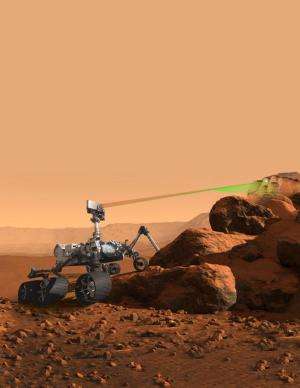Los Alamos laser selected for 2020 Mars mission

NASA announced today that laser technology originally developed at Los Alamos National Laboratory has been selected for its new Mars mission in 2020.
"We are extremely excited to be going to Mars again," said Los Alamos National Laboratory planetary scientist Roger Wiens, Principal Investigator of the newly selected SuperCam team and current principal investigator of the Curiosity Rover's ChemCam Team. "More importantly for the mission, I know SuperCam is the very best remote sensor that NASA can have aboard."
SuperCam builds upon the successful capabilities demonstrated aboard the Curiosity Rover during NASA's current Mars Mission. SuperCam will allow researchers to sample rocks and other targets from a distance using a laser. In addition to harnessing Los-Alamos developed Laser-Induced Breakdown Spectroscopy (LIBS) technology—which can determine the elemental composition of the target from more than 20 feet away—SuperCam adds another spectrum to its laser for Raman and time-resolved fluorescence spectroscopy: A technique partially refined at Los Alamos and the University of Hawaii that provides the molecular makeup of a target, therefore allowing geologists to determine mineralogy and search for organic materials. The enhancements provided by these two institutions include the successful demonstration of performing these measurements at long distances and in miniaturization of the instrumentation.
SuperCam also will add color to its high-resolution visible imaging capability as well as visible and infrared spectroscopy. The updates make SuperCam the perfect instrument to provide fine-scale mineralogy, chemistry, organic detection, and color images, with the added bonus of being able to dust off a surface via laser blasts.
The new instrument will occupy a similar volume on the upcoming rover as the ChemCam instrument does aboard Curiosity and will weigh nearly the same as well.
In addition, Los Alamos will build the detector electronics for the Scanning Habitable Environments with Raman & Luminescence for Organics and Chemicals (SHERLOC) instrument. SHERLOC is a spectrometer that will provide fine-scale imaging and use an ultraviolet (UV) laser to determine fine-scale mineralogy and detect organic compounds. SHERLOC will be the first UV Raman spectrometer to fly to the surface of Mars and will provide complementary measurements with other instruments in the payload. Tony Nelson of Los Alamos's Space Electronics and Signal Processing Group will lead the efforts in constructing the electronics. Los Alamos laser scientists Sam Clegg of Los Alamos's Physical Chemistry and Applied Spectroscopy Group and Wiens are part of the SHERLOC instrument science team.
SuperCam is a continuing effort between Los Alamos and the IRAP research institution in Toulouse France, and the French Space Agency (CNES), with additional collaboration from the University of Hawaii and the University of Valladolid (UVA) in Spain.
According to NASA, agency managers made the instrument selections for the upcoming mission out of 58 proposals received in January from researchers and engineers worldwide. Proposals received were twice the usual number submitted for instrument competitions in the recent past.
Discover the latest in science, tech, and space with over 100,000 subscribers who rely on Phys.org for daily insights. Sign up for our free newsletter and get updates on breakthroughs, innovations, and research that matter—daily or weekly.
The Mars 2020 mission will be based on the design of the highly successful Mars Science Laboratory rover, Curiosity, which landed almost two years ago, and currently is operating on Mars. The new rover will carry more sophisticated, upgraded hardware and new instruments to conduct geological assessments of the rover's landing site, determine the potential habitability of the environment, and directly search for signs of ancient Martian life.
Scientists will use the Mars 2020 rover to identify and select a collection of rock and soil samples that will be stored for potential return to Earth by a future mission. The Mars 2020 mission is responsive to the science objectives recommended by the National Research Council's 2011 Planetary Science Decadal Survey.
The Mars 2020 rover also will help advance knowledge of how future human explorers could use natural resources available on the surface of the Red Planet. An ability to live off the Martian land would transform future exploration of the planet. Designers of future human expeditions can use this mission to understand the hazards posed by Martian dust and demonstrate technology to process carbon dioxide from the atmosphere to produce oxygen. These experiments will help engineers learn how to use Martian resources to produce oxygen for human respiration and potentially oxidizer for rocket fuel.
Provided by Los Alamos National Laboratory




















